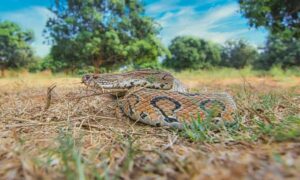
Amin Mandol was harvesting peanuts from a char – a bank of sand and silt – in the Padma, the lower part of the Ganges, when he heard the scream. While pulling up some roots, one of his workers had encountered a snake coiled among the plants. Other workers rushed over and beat the Russell’s viper to death.
Mandol still had several hectares of groundnuts to harvest before the land was submerged by the river after the monsoon rains. But fearing there were more snakes, the workers refused to continue, leaving the fields to the rising waters.
“It caused me a huge loss,” says Mandol, from his home near the Padma riverbank, an area now notorious among local people who fear the Russell’s viper more than any other snake.
Formerly considered a critically endangered species, the viper became protected under the Wildlife (Conservation and Security) Act in 2012. But an apparent rise in numbers has panicked the public, leading to indiscriminate killing of snakes across the country, say conservationists.
When the species was first protected it was found in 17 districts, but this year it has been spotted in 27 of Bangladesh’s 64 districts, says Prof Farid Ahsan, a researcher of the distinctive snake.
According to Ahsan’s estimate, in the years from 2013 to 2023, about 10 people a year were killed by bites from Russell’s vipers. That annual figure has already been reached in 2024. Ahsan and other conservationists have suggested the snake could be benefiting from a decline in natural predators – mongoose, eagles, kites and other snakes such as banded kraits.
The panic over the Russell’s viper has grown, partly due to rumours over the snake’s expanding presence but also because of exaggerated media reports and misinformation on social media.
It has led to open season on snakes in the country, including Burmese pythons, which are not venomous. Social media has been flooded with photos and videos of slain snakes.
Mahfuzur Rahman, founder of Bangladesh’s Deep Ecology and Snake Conservation Foundation, says: “We have observed both national online and print media spreading misinformation with headlines such as ‘Russell’s vipers looming’ or ‘killing-machine Russell’s vipers’.
“One particular post went viral, claiming that Russell’s viper bite has only a 20% survival rate due to its mix of different types of venoms, and falsely stating this snake chases down people. Misinformation of this magnitude turned the Russell’s viper into a national villain.
“As a result, people are killing snakes indiscriminately out of fear that they cause death. They fail to grasp the importance of biodiversity or the consequences of ecological losses,” RaÓhman says.
